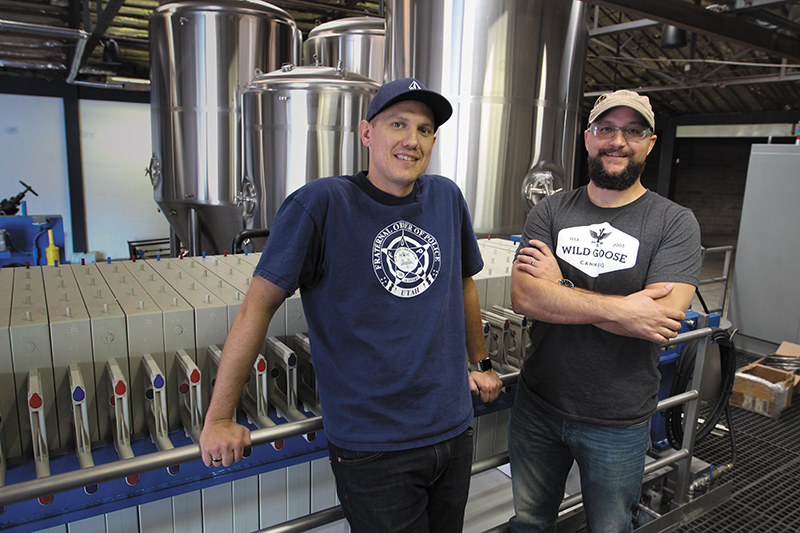
KiiTOS BREWING: A Different Kind of Green Beer
Art
Normally, when I talk about green beer, I’m usually trying to dissuade other would-be craft beer drinkers from steering toward decaliters of mass-produced Saint Patrick’s Day macro beers. You know, the ones that have been dosed with vials of blue dye No. 5. You can imagine my delight when I heard that there’s a new brewery coming to Salt Lake City that’s planning to produce green beers that are more on the environmentally friendly side and less on the chromatically gaudy part of the spectrum. The Kiitos Brewing Company (pronounced ‘ki:tos) hopes that this concept of Earth-friendly brewing will pay off, not only for our planet, but also for the palates of Utah’s beer lovers.
“Being green is something that I’ve always cared about,” says Andrew Dasenbrock, homebrewer and President of Kiitos Brewing. “It’s not always cheap, but whenever possible, I always try to leave as small of a footprint as possible in my daily life. I’d like that to continue in this new enterprise.” Kiitos involves a medium-sized local brewery that uses a HEBS (High Efficiency Brewing System) platform. This is a new, high-end brewing technology that will smoothly produce larger quantities of locally made beer using less water. “It’s also extremely fast,” Dasenbrock says. “It will allow us to brew multiple types of beers per day with much less water than a conventional brew system could.”
The secret of this brewing technology relies on its ability to squeeze as much liquid as possible from the spent grains that are used in the brewing process. “Having this unique ability cuts down on time, weight and waste,” says Dasenbrock. “Combine these benefits with our 100-percent wind-powered facility, and it makes this a very green brewery that’s highly efficient.”
This process is not only efficient in its use of energy, but also leaves behind useful byproducts. Dasenbrock says, “Our waste output will be much friendlier to the environment as well. The water will have a lower PH than most breweries, as well as less solids going into the waste system, and that will save us money.” This is important because their waste fees from the city are based on what they put down the drain. “That’s a part of being green that people sometimes forget about,” he says.
All of this high-tech, super-brewing wizardry is just a cool toy if you don’t have a skilled brewer to utilize it, though. “I’m a homebrewer that’s smart enough to know that my palate exceeds my skills,” Dasenbrock says jokingly. “I got over 200 responses to my ad, including three from China, but the perfect candidate was right under my nose, here in Salt Lake City.”
Dasenbrock’s Head Brewer is Adam Bulson. Bulson is a Michigan guy whose time in the brewhouse has been long and prolific, with breweries that stretch from New York to Oregon. “We clicked immediately, which is real important when you’re going to spend eight to 10 hours a day with someone,” Dasenbrock says. “Plus, he’s got the knowledge and the experience that was integral for this position.”
Bulson’s proficiency and savvy in the brewhouse will come in handy as soon as he begins to shape the direction that the Kiitos brand will take. “We want to make beers that are not only environmentally friendly but will have a noticeable difference in the taste,” Bulson says. “I think the HEBS will get us there.”
He may be right. There are some beers that many brewers will have to shy away from when using conventional brew systems because of the complicated nature of the ingredients. “Grains like rye, wheat and oats are very thick and sticky and are often cut with barley and rice hulls to make them less so in the mash,” Bulson says. “This system will allow us to make beers that are made with 80 percent of these more difficult grains—compared to the more common 20–40 percent that are normally used. This should make a noticeable difference in our beers.”
Highly efficient green beers deserve packaging that reflects all that has gone into them. Keeping with their theme, Kiitos has decided that 16-oz. cans will be their preferred packaging. “Not only are cans more easily recyclable, but they treat the beer better than bottles,” Dasenbrock says. “We also want to use recycled boxes whenever possible.”
Kiitos hopes to debut with 10 beers later this summer, five of which will be year-round offerings. “We are still trying to formulate what those beers will be,” Dasenbrock says. “Adam and I keep going back and forth on what styles will work best. What we do know is that they will be higher-alcohol beers, with some 4-percent ABV beers down the line.”
When the time comes to purchase some of Kiitos’ new brews this summer, you’ll be happy to know that their bottle shop will be able to accommodate not only you but your horse, too! “Our beer cave is going to be massive,” Dasenbrock says. “Four hundred square feet of refrigerated heaven … We’re also planning on a bar area at some point, after we get through all the state’s red tape.”
I’ve been in a lot of breweries and seen a lot of brew systems. Kiitos has overloaded my tiny brain—to the point where I forgot to ask what the hell is up with that name? “‘Kiitos’ is Finnish slang for ‘thanks’ or ‘thank you,’” says Dasenbrock. “My family is from Finland—it’s part of my heritage. Plus, it just sounds cool.”
I predict that there will be a lot of happy, beer-coated tongues out there this summer exclaiming, “Kiitos!” to this new Utah brewery.